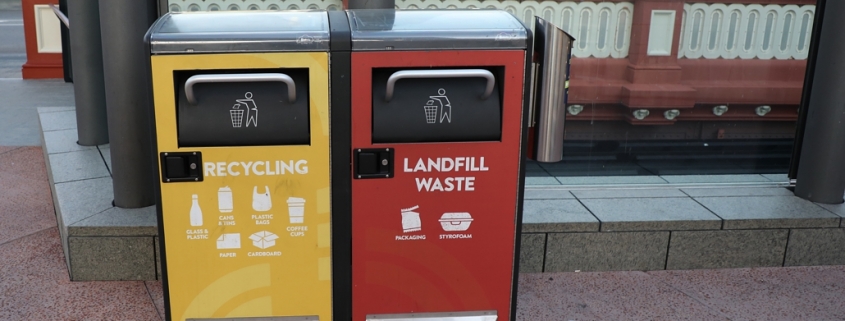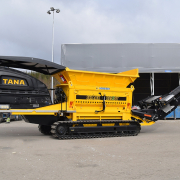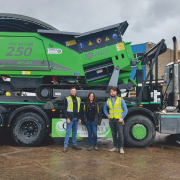Less Waste – More Resources: Australia’s National Waste Policy
Australia is planning to implement a circular economy – with all the advantages that this brings.
The country’s National Waste Policy, published in 2018, provides a framework for collective national action on waste management, recycling and resource recovery until 2030. Up to now, the country has landfilled a large part of its waste or taken it to other countries. But the attitude towards waste has changed fundamentally: “The value of resources and embodied energy in waste are now recognized. There is an economic opportunity and growing desire to see our resources recaptured and recirculated within our economy,” the Australian Government as well as the country’s state and territory governments and the Australian Local Government Association underlined, when they explained, why waste resource management is so important. As reported, Australia generates about 67 million tons of waste per annum, which equates to roughly 2.7 tons per person. Every year, 37 million tons are making their way into recycling, while two million tons of the waste volume are dedicated to energy production. In the financial year 2018/2019 (July to June), about 4.5 million tons of waste were exported, mostly to Asian countries. In 2018, more than 21 million tons were landfilled, special media referred to the latest National Waste Report last year; organics accounted for about 10 million tons.
Although Australia is recovering 58 percent of its waste, the materials lost to landfill – such as plastics, paper, glass, metals, textiles, masonry, food and other organic materials – “are resources that are going to waste”, the policy paper informed. From 2014 to 2015, waste management services in Australia were valued at 12.6 billion Australian Dollar (9.07 billion US-Dollar), and the sale of recovered materials was valued at 2.9 billion Australian Dollar (2.08 billion US-Dollar). Waste-related activities added a total value of 6.9 billion Australian Dollar (nearly 5 billion US-Dollar) to the economy, accounting for 0.43 percent of GDP (gross domestic product). Furthermore, around 50,000 people are directly employed in waste-related activities, including employees in the waste and material recovery industries, the business sector and local governments, the authors of the paper wrote. For every 10,000 tons of waste that is recycled, 9.2 jobs were created (compared with 2.8 jobs if the same amount of waste was sent to landfill). “Better management of waste can have a financial benefit for everyday Australians,” the authors stated. “Moving to a more circular economy has the potential to create new jobs and benefit the economy overall.”
As emphasized, applying the circular economy principles to waste management in Australia would require changes to product design, production, use and reuse, recycling and disposal. “It is a whole-of-system approach that requires accounting of the full cost and life-cycle of materials.” At the same time, this approach would help to minimize reliance on virgin materials and maximize the economic value of resources. “Some materials, such as particular hazardous waste products, may still need to be disposed of. Most other manufactured goods and materials are resources that can be reused, recycled and reprocessed over and over.”
National Action Plan
To implement this policy, in 2019 the National Waste Policy Action Plan was set up; the described goals and actions “will guide investment and national efforts to 2030 and beyond”. There are seven targets, which are to be measured against baselines in the 2018 National Waste Report:
- “Ban the export of waste plastic, paper, glass and tires, commencing in the second half of 2020
- Reduce total waste generated in Australia by 10 percent per person by 2030
- 80 percent average resource recovery rate from all waste streams following the waste hierarchy by 2030
- Significantly increase the use of recycled content by governments and industry
- Phase out problematic and unnecessary plastics by 2025
- Halve the amount of organic waste sent to landfill by 2030
- Make comprehensive, economy-wide and timely data publicly available to support better consumer, investment and policy decisions”.
Different areas of Responsibility
While the Australian government has set the direction with the National Waste Policy, the implementation of the National Waste Policy Action Plan is the responsibility of the country’s states, which can also enact legislation in the field of waste management. The city councils are responsible for the collection and disposal of household waste, usually together with private companies; contracts are then assigned through public tendering. Many municipalities handle the disposal of commercial waste as well. However, this is not standardized, because depending on the region, the companies themselves have to sign contracts with disposal companies.
As far as waste for recycling is concerned, the materials intended for recycling – such as paper, plastic packaging and glass containers – are usually collected in Australian households in one bin. However, local authorities can determine which materials are to be collected in which garbage cans.
Product Stewardships
The Product Stewardship Act 2011, which was reviewed in July this year, provides the framework to effectively manage the environmental, health and safety impacts of products, and, in particular, those impacts associated with the disposal. According to the information on the homepage of the Department for Agriculture, Water and the Environment, it presents “a flexible and practical approach to product stewardship by recognizing that each product, material and industry is unique”. It would allow products to be regulated or product stewardship arrangements to be accredited by the Australian government in a voluntary, co-regulatory and mandatory manner. Voluntary arrangements are MobileMuster, the official recycling program of the mobile phone industry, and FluoroCycle, the national recycling program for mercury-containing lamps.
The National Television and Computer Recycling Scheme (NTCRS) was established in 2011. The Product Stewardship (Televisions and Computers) Regulations provide the legislative framework for the scheme. Its operation is managed by four co-regulatory arrangements, Australian and New Zealand Recycling Platform (ANZRP), Ecycle Solutions, Electronics Product Stewardship Australasia (EPSA) and MRI PSO. As reported, more than 1,800 collection services have been made available to the public, and more than 360,000 tons of TV and computer e-waste have been collected and recycled. The Tire Stewardship Australia (TSA) has been established by tire importers to administer the national tire product stewardship scheme, launched in 2014. Through the scheme, TSA aims to increase domestic tire recycling, expand the market for tire-derived products and reduce the number of Australian end-of-life tires that are sent to landfills, exported as baled tires or illegally dumped, the department describes the tasks. TSA is responsible for administering the scheme and conducting education, communication and market development activities. The Australasian Recycling Label (ARL), an initiative of Planet Ark and APCO (Australian Packaging Covenant Organization), has been endorsed by all Australian governments to help make the recycling of plastics and packaging easier. It provides recycling information so Australians can put the right packaging in the right bin.
Regarding food waste, the Australian government intends to halve the volume by 2030. Each year, Australia produces around 7.3 million tons of food waste across the supply and consumption chain, the Department for Agriculture, Water and the Environment reported. Food waste would cost the national economy billions a year. “The environmental cost is also high, with food waste accounting for about 5 percent of our national greenhouse gas emissions.” Over 1,460 giga-liters of water is used annually to grow Australian produce which is then discarded. The 2017 National Food Waste Strategy provides a framework for collective action to halve food waste, as well as actions identified in the National Waste Policy Action Plan. To reach this aim would be a significant challenge that could only be achieved by working in collaboration with food supply chains, all tiers of government, consumer groups and non-government organizations, the information says. Therefore, suitably experienced and skilled entities were invited to submit a partnering proposal until September this year “to establish an independent, long-term governance entity”. The Australian government is providing up to 4 million Australian Dollar (nearly 2.9 million US-Dollar) over four years to establish the governance entity.
Recycling facilities
“Right now, there are 193 material recovery facilities in Australia. Most are hand-sorted; nine are semi-automated, and nine are fully automated. These are nowhere near sufficient to sort Australia’s annual recycling,” the online publication The Conversation, a network of not-for-profit media outlets that publish news stories written by academics and researchers, reported in August last year. The sorting would take place by mechanical-biological treatment plants and material recovery facilities. According to the information, the nine more modern facilities in Australia use automated optical sorting systems to take out the manual and mechanical sorting. “A new facility in New South Wales can detect eight different types of material: aluminum, cardboard, glass, HDPE plastic, mixed paper, newspaper, PET plastic, and steel,” the author Jeff Seadon from Auckland University of Technology wrote. He is convinced that as worldwide demand for high quality, clean recycling material increases, Australia must upgrade its technology. “Incentives and financial help for recycling companies may be necessary to see Australia develop a viable domestic recycling industry.”
Governmental support
Australia’s waste and recycling industry will be transformed by the Recycling Modernization Fund (RMF), which would generate 600 million Australian Dollar (about 434 million US-Dollar) of recycling investment, the Australian Department of Agriculture, Water and the Environment is convinced. “By mid-2024 when the full waste export ban comes into effect, Australia must recycle around 650,000 additional tons of waste plastic, paper, glass and tires each year.” The Australian government would invest 190 million Australian Dollar into this fund. That would contribute to recycling infrastructure investment and “drive a billion-dollar transformation of Australia’s waste and recycling capacity”. More than 10,000 jobs would be created, and over 10 million tons of waste diverted from landfills. Furthermore, the government has set up a separate process to deliver a national solution for mixed-paper recycling, the information on the department’s homepage says. The Australian government was inviting states and territories to partner with industry (and other states) to submit project proposals for new paper processing facilities that contribute to a national solution; the closing date was in July this year.
There are also announcements from states. The Australian and ACT (Australian Capital Territory) governments intend to provide 21 million Australian Dollar to upgrade the ACT Material Recovery Facility (MRF). The upgraded plant would have the capacity to improve the quality and marketability of 23,000 tons of paper and mixed cardboard, 1,800 tons of mixed plastics and 14,000 tons of glass from the ACT and five regional New South Wales councils annually, the interested reader could learn. Work is expected to begin in 2020, and completion is expected to largely achieved in 2021-22.
Western Australia is funding new plastics and tire processing infrastructure. As reported, 15 million Australian Dollar will be provided to process plastics and tires across the state. Access will also be provided to industrial zoned land valued at 5 million Dollar for processing infrastructure. The Australian government will contribute 20 million Dollar. “State funding will need to be matched or exceeded by industry investment. The total combined investment in local processing is likely to be greater than 60 million Dollar. Projects in regional and remote Western Australia are encouraged.”
Opportunities
Although the Australian economy is impacted by the coronavirus pandemic and the country – as media reported – is set up for its first recession in 29 years, there are tenders. The Australian government’s investment promotion agency Austrade works to inform investors about growth opportunities in different areas, including a circular economy. Interested enterprises can find the corresponding information on the internet: https://www.austrade.gov.au/International/Invest/opportunities
Tenders are also published at www.australiantenders.com.au/search/tenders/ or www.globaltenders.com/tenders-australia.php/.
(GR32020, Page 20, Photo: Hans-Jürgen Schwanke)











